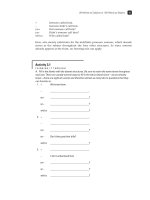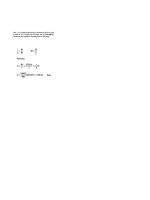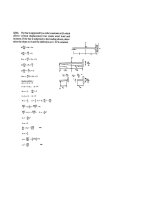Lecture Mechanics of materials (Third edition) - Chapter 4: Pure bending
Bạn đang xem bản rút gọn của tài liệu. Xem và tải ngay bản đầy đủ của tài liệu tại đây (1.23 MB, 10 trang )
<span class='text_page_counter'>(1)</span><div class='page_container' data-page=1>
<b>MECHANICS OF </b>
<b>MATERIALS</b>
<b>Ferdinand P. Beer</b>
<b>E. Russell Johnston, Jr.</b>
<b>John T. DeWolf</b>
<b>Lecture Notes:</b>
<b>J. Walt Oler</b>
<b>Texas Tech University</b>
CHAPTER
</div>
<span class='text_page_counter'>(2)</span><div class='page_container' data-page=2>
Pure Bending
Pure Bending
Other Loading Types
Symmetric Member in Pure Bending
Bending Deformations
Strain Due to Bending
Beam Section Properties
Properties of American Standard Shapes
Deformations in a Transverse Cross Section
Sample Problem 4.2
Bending of Members Made of Several
Materials
Example 4.03
Reinforced Concrete Beams
Sample Problem 4.4
Stress Concentrations
Plastic Deformations
Members Made of an Elastoplastic Material
Example 4.03
Reinforced Concrete Beams
Sample Problem 4.4
Stress Concentrations
Plastic Deformations
Members Made of an Elastoplastic Material
Plastic Deformations of Members With a Single
Plane of S...
Residual Stresses
Example 4.05, 4.06
Eccentric Axial Loading in a Plane of Symmetry
Example 4.07
Sample Problem 4.8
Unsymmetric Bending
Example 4.08
</div>
<span class='text_page_counter'>(3)</span><div class='page_container' data-page=3>
Pure Bending
<i>Pure Bending</i>: Prismatic members
</div>
<span class='text_page_counter'>(4)</span><div class='page_container' data-page=4>
Other Loading Types
• <i>Principle of Superposition</i>: The normal
stress due to pure bending may be
combined with the normal stress due to
axial loading and shear stress due to
shear loading to find the complete state
of stress.
• <i>Eccentric Loading</i>: Axial loading which
does not pass through section centroid
produces internal forces equivalent to an
axial force and a couple
• <i>Transverse Loading</i>: Concentrated or
</div>
<span class='text_page_counter'>(5)</span><div class='page_container' data-page=5>
Symmetric Member in Pure Bending
∫ =
=
∫ =
=
<i>dA</i>
<i>z</i>
<i>M</i>
<i>dA</i>
<i>F<sub>x</sub></i> <i><sub>x</sub></i>
σ
σ
0
0
• These requirements may be applied to the sums
of the components and moments of the statically
indeterminate elementary internal forces.
• Internal forces in any cross section are equivalent
to a couple. The moment of the couple is the
section <i>bending moment</i>.
• From statics, a couple M consists of two equal
and opposite forces.
• The sum of the components of the forces in any
direction is zero.
• The moment is the same about any axis
</div>
<span class='text_page_counter'>(6)</span><div class='page_container' data-page=6>
Bending Deformations
Beam with a plane of symmetry in pure
bending:
• member remains symmetric
• bends uniformly to form a circular arc
• cross-sectional plane passes through arc center
and remains planar
• length of top decreases and length of bottom
increases
• a <i>neutral surface</i> must exist that is parallel to the
upper and lower surfaces and for which the length
does not change
</div>
<span class='text_page_counter'>(7)</span><div class='page_container' data-page=7>
Strain Due to Bending
Consider a beam segment of length <i>L</i>.
After deformation, the length of the neutral
surface remains <i>L</i>. At other sections,
</div>
<span class='text_page_counter'>(8)</span><div class='page_container' data-page=8>
Stress Due to Bending
• For a linearly elastic material,
linearly)
varies
(stress
<i>m</i>
<i>m</i>
<i>x</i>
<i>x</i>
<i>c</i>
<i>y</i>
<i>E</i>
<i>c</i>
<i>y</i>
<i>E</i>
σ
ε
ε
σ
−
=
−
=
=
• For static equilibrium,
∫
∫
∫
−
=
−
=
=
=
<i>dA</i>
<i>y</i>
<i>c</i>
<i>dA</i>
<i>c</i>
<i>y</i>
<i>dA</i>
<i>F</i>
<i>m</i>
<i>m</i>
<i>x</i>
<i>x</i>
σ
σ
σ
0
0
First moment with respect to neutral
plane is zero. Therefore, the neutral
surface must pass through the
section centroid.
• For static equilibrium,
</div>
<span class='text_page_counter'>(9)</span><div class='page_container' data-page=9>
Beam Section Properties
• The maximum normal stress due to bending,
modulus
section
inertia
of
moment
section
=
=
=
=
=
<i>c</i>
<i>I</i>
<i>S</i>
<i>I</i>
<i>S</i>
<i>M</i>
<i>I</i>
<i>Mc</i>
<i>m</i>
σ
A beam section with a larger section modulus
will have a lower maximum stress
• Consider a rectangular beam cross section,
<i>Ah</i>
<i>bh</i>
<i>h</i>
<i>bh</i>
<i>c</i>
<i>I</i>
<i>S</i>
6
1
3
6
1
3
12
1
2 = =
=
=
Between two beams with the same cross
</div>
<span class='text_page_counter'>(10)</span><div class='page_container' data-page=10></div>
<!--links-->









